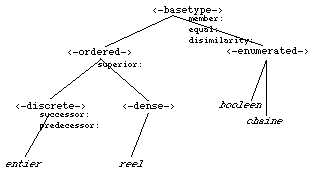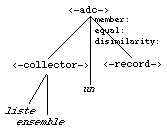Appendix
5. Adding data types to TROEPS
TROEPS
comes with a set of primitive data types declared in the
trtdum
module. This module must be loaded in order to uses the corresponding types (
entier,
chaine,
reel,
booleen).
In
TROEPS,
primitive data types are declared in a general type system which provides the
basic operations of type checking but also those of sub-type relationship
inference. This is the basis for building classification mechanisms, type
checking and dissimilarity computation. This type system is extensible. So, new
types can be added through the definition of an abstract data type (
ADT)
and will behave just like basic types.
The
procedure for using new types is the following:
- Declaring
an abstract data type;
- Using
this type in a concept field (see the "concept field" section);
- Building
up type expressions stored in class fields (see the "class field" section);
- Using
values of the types in an instance, classifying the instance, etc.
These
steps are further detailed below.
Categories
of data types and their properties
Data
types are
TALK
structures. They are presented here for illustration purposes. However, for
being recognised by
TROEPS
they must be declared as below.

Figure
16: The abstract data type hierarchy in the
TROEPS
type system. The types in italics are those defined in the
trtdum
standard type module; other types can be added.

Figure
17: The abstract data constructor hierarchy in the
TROEPS
type system. The constructors in italics are those defined in the
trtdum
standard type module; it not currently possible to add type constructors to
TROEPS.
Declaring
data types
An
ADT
is generally defined through a membership predicate (for deciding if something
belongs to the type), an equality predicate (for testing the equality of two
values of the type), a string function which returns a string representing a
value of the type (for printing purpose). Moreover, a similarity function
returns a measure of similarity between two values of the type and ordered
types must have an order predicate.
For
instance, the date abstract data type can be described with
datep
as membership predicate,
date-equal-p
for equality predicate and
date-anterior-p
as order function. The following table represents the definition of basic data
types available in
trtdum:
|
name
|
class
|
membership
|
equality
|
order
|
successor/
predecessor
|
dissimilarity
|
printer
|
|
entier
|
discrete
|
intp
|
i=
|
i>
|
i1+/i1-
|
iabs
o i-
|
string
|
|
reel
|
dense
|
floatp
|
f=
|
f>
|
-
|
fabs
o f-
|
string
|
|
booleen
|
enumerated
|
true
|
eq:t?()
|
-
|
-
|
eq:0.?1.
|
string
|
|
chaine
|
enumerated
|
stringp
|
string=
|
-
|
-
|
eq:0.?1.
|
id
|
TROEPS
also uses two collection constructors: list (
liste)
and set (
ensemble).
A collection type is built from a collection operator and a basic type.
Collectors are declared through abstract data collectors which enable to check
if a collection corresponds to its type, to compare two collections, to order
them and, if required, to determine the size of a collection (for cardinality
checking).
In the current version of
TROEPS,
it is not possible to add data collectors.
Using
data types
Once
data types have been declared, it is possible to describe fields for which the
values can be values of the new data type. For that purpose, the type
descriptor of the concept field has to be filled by the corresponding
ADT
(see the "concept" section). Once this has been achieved, it is possible to
restrict the domain of the field in particular classes with the help of the
domain,
intervals,
except
or
card
descriptors of the class fields (see the "class" section). These type
expressions can be expressed in the knowledge representation language as follows:
typexp(ADT)
=
*
where
v
are values of the
ADT
and
r
[propersubset]
N+[union]{+[infinity]}.
Now,
instances of the concept can be created: the type system takes care of the
membership of the field value to the type; they can be classified, it takes
care of the membership of the value to the domain represented by the class
field descriptors; new classes can be categorised, the sub-type relationship
between their respective field definition is computed by the type module.
Examples
As
an example, it is possible to create an abstract data type for the time type
provided with
TALK.
Thanks to the generic arithmetic, it is already possible to test equality (
=)
superiority (
>)
and increment (
1+)
of the time structures. It is also possible to test the membership to the type (
timep)
and to print time values (
string).
All this is communicated to
TROEPS
by only one
TALK
statement which can be compiled and loaded:
(tr-create-adt <-discrete-> time
member: timep
equal: equal
superior: >
string: string
successor: 1+
predecessor: 1-
disimilarity: (lambda (v1 v2) (float (abs (- v1 v2))))
printer: print
reader: read
)
API
Services
provided by ADT
The
only necessary primitive for extending the type system is
tr-create-adt.
- (tr-create-adt
adt
name rest: listdesc
) macro
in [libtrp]
-> adt
,
adt
adt,
name
stringnas,
listdesc
[key value]*
- Creates
a new
ADT
of kind
adt
and name
name
and returns it. The attributes of the
ADT
are provided through a set of descriptors (
listdesc)
whose meaning is given by the following:
|
key |
applicabi-lity |
value |
meaning |
|
member: |
all |
anything
->
B
|
Does
the value belong to the ADT?
|
|
equal: |
all |
VxV
->
B
|
Are
the values equal?
|
|
string: |
all |
V
->
string
|
The
string representation of a value
|
|
disimilarity: |
all |
VxV
->
float
|
The
dissimilarity measure between two values
|
|
superior: |
ordered |
VxV
->
B
|
Does
the first value precede the second one?
|
|
successor: |
discrete |
V
->
V
|
The
successor of a value
|
|
predecessor: |
discrete |
V
->
V
|
The
predecessor of a value
|
|
reader: |
all |
strm
->
V
|
The
reading of a value in a stream
|
|
printer: |
all |
Vxstrm
->
void
|
The
printing of a value in readable format
|
These
primitives can be exported to anyone.
- (tr-find-adt
name) function
in [libtrp]
-> adt,
name
stringnas
- Retrieves
and returns the
ADT
of name
name.
When no such
ADT
is known, returns
().
- (tr-adt-p
anything) function
in [libtrp]
-> boolean,
anything
anything
- Returns
anything
if
anything
is an
ADT,
()
otherwise.
- (tr-adt-top
name) function
in [libtrp]
-> type,
name
stringnas
- Returns
the type which corresponds to the domain of all the members of the
ADT
adt.
Services
provided for types and values
These
primitives are supported for types declared through
ADT.
The type argument is the one stored into the concept and class fields (e.g. the
result of the call to
(.conceptslot-type
conceptslot)
).
These primitives are used for programming efficiently the classification and
categorisation systems. It is possible to use them when only an
ADT
(and not a type) is available by retrieving the most general type (through
(tr-adt-top
adt)
).
- (tr-type-p
anything) macro
in [libtrp]
-> boolean,
anything
anything
- Returns
anything
if
anything
is a type,
()
otherwise.
- (tr-type-member-p
type
value
) function
in [libtrp]
->
boolean,
type
type,
value
anything
- Checks
the membership of value to the type (domain)
type.
Returns
value
if it is type compliant,
()
otherwise.
- (tr-type-equal-p
type
value1 value2
) function
in [libtrp]
->
boolean,
type
type,
value1
anything,
value2
anything
- Tests
the equality of two values declared through the type
type.
Returns
value1
if
value1
and
value2
are equal (in the sense of the
ADT
equal predicate) and
()
otherwise.
- (tr-type-disimilarity
type
value1 value2
) function
in [libtrp]
-> float,
type
type,
value1
anything,
value2
anything
- Computes
a dissimilarity measure (in the sense of the
ADT
dissimilarity function) for two values declared through the type
type
and returns it.
- (tr-type-cardinal
type
value
) function
in [libtrp]
-> integer,
type
type,
value
anything
- Computes
a size measure (in the sense of the
ADC
size function) for a value declared through the type
type
and returns it.
- (tr-type-successor
type
value
) function
in [libtrp]
-> anything,
type
type,
value
anything
- Computes
the successor (in the sense of the
ADT
successor function) for a value declared through the type
type
and returns it.
- (tr-type-predecessor
type
value
) function
in [libtrp]
-> anything,
type
type,
value
anything
- Computes
the predecessor (in the sense of the
ADT
predecessor function) for a value declared through the type
type
and returns it.
- (tr-type-superior-p
type
value1 value2
) function
in [libtrp]
-> boolean,
type
type,
value1
anything,
value2
anything
- Tests
the superiority of two values declared through the type
type.
Returns
value1
if
value1
is superior (in the sense of the
ADT
order predicate) to
value2
and
()
otherwise.
-
(
tr-type-string
type
value
) generic
in [libtrp]
-> string,
type
type,
value
anything
- Returns
a string corresponding to the representation (in the sense of the
ADT
string function) of the value
value
declared through the type
type.
- (tr-type-read-value
type
string
) function
in [libtrp]
-> anything,
type
type,
string
string
- Returns
the value of type
type
corresponding to the string
string.
- (troeps.type.compare
type1
type2
)
--
generic
in [libtrp]
-> symbol,
type1
type,
type2
type NIY
- Checks
the sub-typing of the type (domain)
type1
with
regard to that of
type2.
Returns
type1
if
type1
is a super-type of
type2,
type2
if it is a super-type of
type1,
their intersection otherwise (which can be
()).
Accessing
TROEPS types
TROEPS
primitives allows to access the types stored by the type system (in order, for
instance, to compare them). These accessors are provided by the representation
model in order to store the information related to the type system. They are
used in read-write mode by the type module and in read mode by the any other
module.
- (troeps.type.class-type
class) function
in [libtrp]
(troeps.type.concept-type
concept) function
in [libtrp]
(troeps.type.classslot-type
classslot) function
in [libtrp]
(troeps.type.conceptslot-type
conceptslot) function
in [libtrp]
-> type,
class
class,concept
concept,
classslot
classslot,
conceptslot
conceptslot,
type
type
- Returns
the type associated to the entity.


